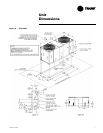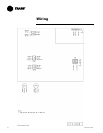
12 PKG-SVX17A-EN
WARNING:
Hazardous Pressures!
Coil has a nitrogen holding
charge. Do not remove seal caps
by heating the caps while coil is
under pressure. Depress the
gauge port valve cores to gradu-
ally relieve nitrogen holding
charge. Remove valve cores
before removing the tubing seal
caps. Failure to properly relieve
pressure could result in death or
serious injury.
1. Remove both seal caps from the
indoor unit connection stubs.
CAUTION:
Equipment Damage!
Do not remove the seal caps from
refrigerant connections until pre
-
pared to braze refrigerant lines to
the connections. Excessive expo-
sure to atmosphere may allow
moisture or dirt to contaminate
the system, damaging valve seals
and causing ice formation in sys
-
tem components.
2. Turn nitrogen supply on. Nitrogen
enters through liquid line gauge
port.
WARNING:
Hazard of Explosion and Deadly
Gases!
Never solder, braze or weld on
refrigerant lines or any unit com
-
ponents that are above atmo-
spheric pressure or where
refrigerant may be present.
Always remove refrigerant by fol
-
lowing the guidelines estab-
lished by the EPA Federal Clean
Air Act or other state or local
codes as appropriate. After refrig
-
erant removal, use dry nitrogen to
bring system back to atmospheric
pressure before opening system
for repairs. Mixtures of refriger-
ants and air under pressure may
become combustible in the pres-
ence of an ignition source leading
to an explosion. Excessive heat
from soldering, brazing or weld-
ing with refrigerant vapors
present can form highly toxic
gases and extremely corrosive
acids. Failure to follow all proper
safe refrigerant handling prac
-
tices could result in death or seri-
ous injury.
3. Braze the liquid line connections.
4. Open the gauge port on the dis-
charge line and then braze the dis-
charge line to the connection stub.
Nitrogen will bleed out the open
gauge port on the discharge line.
5. Shut off nitrogen supply.
Leak Check
After the brazing operation of the out-
door and indoor refrigerant lines is
complete, check the field brazed con
-
nections for leaks. Pressurize the sys-
tem through the gauge port with dry
nitrogen to 200 psi. Use soap bubbles
or other leak-checking methods to
ensure that all field joints are leak
free. If not, release pressure, repair
and repeat the leak test.
System Evacuation
1. After completion of leak check,
replace suction, liquid and dis
-
charge valve cores, and evacuate
the system.
2. Attach appropriate hoses from the
manifold gauge to suction and dis-
charge line gauge ports.
Note: Unnecessary switching of hoses
can be avoided and complete evacua
-
tion of lines leading to a sealed sys-
tem can be accomplished with
manifold center hose and connecting
branch hose to cylinder of R-410A and
vacuum pump.
3. Attach center hose of manifold
gauges to the vacuum pump.
4. Evacuate the system to hold a 350
micron vacuum.
5. Close off the valve to the vacuum
pump and observe the micron
gauge. If gauge pressure rises
above 500 microns in one (1)
minute, evacuation is incomplete or
the system has a leak.
6. If vacuum gauge does not rise
above 500 microns in one (1)
minute, the evacuation should be
complete.
7. With vacuum pump and micron
gauge blanked off, open the valve
on R-410A cylinder and allow refrig-
erant pressure to build up to 100
psig.
8. Close valve on the R-410A supply
cylinder. Close valves on the mani-
fold gauge. Set and remove the
refrigerant charging hoses from the
discharge and suction gauge ports.
9. Leak test the entire system. Using
proper procedures and caution,
repair any leaks found and repeat
the leak test.
Refrigerant Charging Procedure
If charging by weight, refer to refriger-
ant charges that are provided in Table
3. If additional refrigerant is needed
because of length of line, calculate the
requirements using Table 4. Charge
by weight through the gauge port on
the suction line in the indoor unit.
When charging is complete, replace
the cap on the gauge port.
Insulating and Isolating
Refrigerant Lines
Insulate the entire discharge line with
refrigerant piping insulation. Also
insulate any portion of the liquid line
exposed to temperature extremes.
Insulate and isolate liquid and dis
-
charge lines from each other. Isolate
refrigerant lines from the structure
and any ductwork.
Note: To prevent possible noise or
vibration, be certain to isolate refriger-
ant lines from the building.
Installation


















